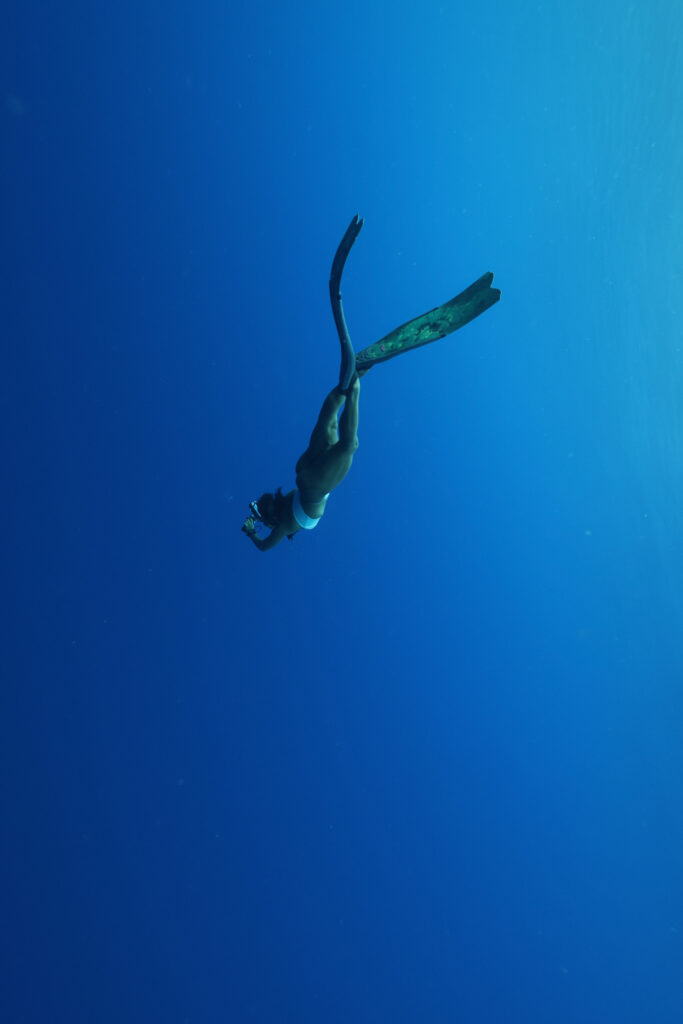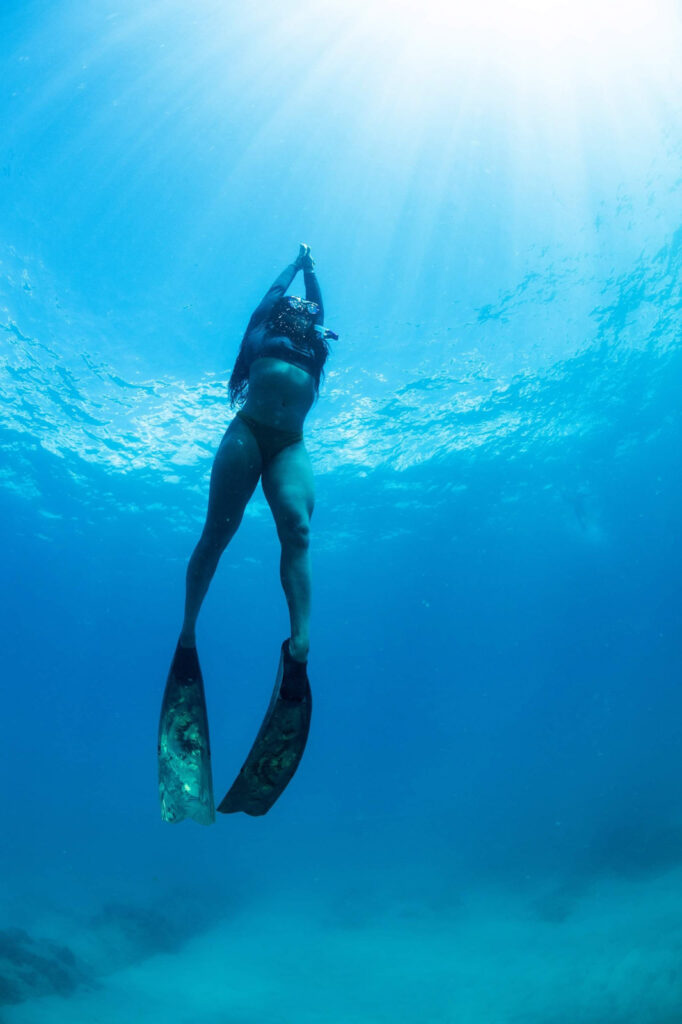A Guide to Freediving in Hawaii

Picture this: You’ve landed in the Aloha State, and the ocean is calling. Whether you’re a seasoned freediver chasing new depths, a snorkeler ready to level up, or someone dreaming of becoming a real-life mermaid—Hawaii is one of the best places on Earth to dive into this world.
I first called Oahu home during the pandemic, and I’ve returned every year since 2015. What started as curiosity evolved into something much more: freediving became one of the most transformative experiences of my life. And I want to help you experience it, too.
Step One: Take a Freediving Course (and Why It Matters)
The first thing you need? A proper freediving course with a certified instructor or agency. Safety is non-negotiable. Unlike scuba diving, which relies on equipment and a divemaster, freediving is about your body, your breath, and the people around you. And no credible dive group will take you out unless you’re trained.
In a beginner course, you’ll learn:
- Equalization techniques
- How to enter the water efficiently
- Static breath hold training
- Rescue and blackout response
- Safety protocols for buddy diving
Even if you never plan to go pro, these are essential skills for anyone who wants to dive safely and confidently.
I recommend looking for courses certified by:
- FII (Freediving Instructors International)
- PFI (Performance Freediving International)
Both are trusted names focused solely on freediving education.
Best Freediving Shops & Instructors in Hawaii
- Deep Freediving Instruction – I got my certification from this club and joined them on a few dives after the course. They are an amazing crew and I highly recommend them if you are on Oahu.
- Ocean Freediving – I’ve been on on one dive with this club and had a blast, located on Oahu.
- Amelia de Los Rios – Amelia is a complete badass and was a huge source of inspiration for me during my time on Oahu.
- Kurt Chambers – Hosts courses around Big Island, Maui & Oahu.
- Kona Freedivers – Located on Big Island.
- Freedive Ohana – Female dive club on Maui.
Finding Dive Buddies & Groups
Once certified, connect with local freedivers. Most dive clubs offer ongoing trips for a small boat fee, even if you’re newly certified. These outings are a great way to sharpen your skills.
Another option is joining freediving groups on Facebook such as Oahu Freedivers , they are filled with seasoned divers and newly certified divers alike.
Shore Freediving locations
Technically you can “freedive” anywhere, even at Waikiki but some locations are better than others depending on several factors like depth, wildlife, facilities (parking and restroom), access, etc.
Here are the best shore freediving locations on Oahu.
Makua beach

My favorite beach in Hawaii. Remote, wild, and usually with great visibility. There are no facilities—and I hope it stays that way. The lack of infrastructure keeps the crowds at bay. You might see dolphins in the morning or hear whale songs in the winter months. Sunset here is breathtaking, with a landscape that remains untouched by resorts or development.
- Depth: 20 – 50 ft
- Parking: yes.
- No amenities (showers or bathrooms)
Makaha beach
Another west-side gem, known for its magical underwater sea caves. This is my second favorite spot to dive. Use caution—the surface swim out to the caves is about 250 meters and can be exhausting, especially in current or swell. A kayak or paddleboard is a smart move here. And always bring a dive flag or surface marker buoy.
- Depth: 20-50 ft.
- Parking: yes.
- Amenities: Showers and bathrooms.
Kewalo pipe from Point Panic

There’s no sandy beach here—just concrete steps that drop straight into the ocean. Parking is limited, especially on weekends, and the area is shared with fishermen, scuba divers, spearfishers, and other freedivers. The main attraction is the old storm drain pipe that runs far out into the ocean, offering decent depth and a healthy (though not overly colorful) reef. Wildlife here includes eels, rays, and even the occasional dolphin.
- Depth: 45 – 65 ft.
- Parking: yes but limited.
- Amenities: Showers and bathrooms.
Sharks Cove
This spot is all lava rock, reef, and underwater caverns. It’s one of my favorites for rock formations and unique swim-throughs. Plus, the swim out is short and the entry is easy for most fitness levels. Just be aware that conditions can shift quickly on the North Shore.
- Depth: 20 – 40 ft.
- Parking: yes but limited.
- Amenities: Showers, bathrooms & restaurants across the street
Kahe point aka Electric Beach
Electric beach got it’s name from the power plant next door that releases warm water into the ocean. Freedivers love it because of the consistent visibility and short swim to depth. The beach itself is small with limited space, but we spend more time in the water than on the sand anyway. Pro tip: Do not leave valuables visible in your car. This area is notorious for break-ins.
- Depth: 20 – 30 ft.
- Parking: Yes.
- Amenities: Showers and bathrooms.
Highlights and Tips for Freediving in Hawaii
- Always bring a dive flag and surface marker buoy on dives.
- Never dive alone.
- Always check the weather before heading out and educate yourself on tides, currents and waves.
- Lock your car and never leave your valuables inside. For less valuable items, keep out of sight. Oahu has a high rate of car theft and break-ins, so it pays to be cautious and attentive.
- Arrive early for decent parking and to beat the crowds.
- When in doubt, DON’T GO OUT.
Freediving Gear
- Mask
- Weight belt
- Wetsuit
- Fins
- Surface marker buoy
- Dive flag
- Dive watch
I’ve written a short guide to help you navigate through all of the freediving essentials here.
Freediving in Hawaii was a deeply magical chapter of my life. It brought me closer to nature, closer to myself, and sparked a fierce environmental awareness I carry with me to this day. If you feel even the slightest pull toward the water—follow it.
You might just come back changed, too.
Related
Leave a Reply Cancel reply
You must be logged in to post a comment.
Before you go, be sure to subscribe so you don't miss out on the latest blog posts, opportunity to travel with me and more!
Explore With Me
Thank you!
You have successfully joined our subscriber list.
design by oregon lane
privacy policy
all rights reserved